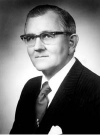Through his entire career Fred Hinger was never satisfied with commercially produced percussion products and spent much time creating his own drumsticks and tympani mallets while he was in the Philadelphia Orchestra. He found that tympani handles made of bamboo produced a much larger sound than the traditional wood handles found on virtually all commercially produced tympani mallets. People started asking him to make the same mallets for them, and as time went on he started selling these hand sewn tympani mallets to students and other  professionals. In the early 1960’s, he began to experiment with other handle materials and found that an aluminum tubular handle would produce the same sound characteristics of the bamboo, but were much more consistent and could be duplicated much more easily. He also found that by gluing the felt on the tympani mallets instead of sewing, the usable life of the stick became greater, and the sound of what we called slap, or the loosening of the felt around the core, was eliminated. As business picked up in the early 1960’s he registered the trademarks Hinger and Touch-Tone, which eventually became the company name.
professionals. In the early 1960’s, he began to experiment with other handle materials and found that an aluminum tubular handle would produce the same sound characteristics of the bamboo, but were much more consistent and could be duplicated much more easily. He also found that by gluing the felt on the tympani mallets instead of sewing, the usable life of the stick became greater, and the sound of what we called slap, or the loosening of the felt around the core, was eliminated. As business picked up in the early 1960’s he registered the trademarks Hinger and Touch-Tone, which eventually became the company name.
When Bill Hinger joined the United States Army Band in Washington, D.C. in 1967, all tympani mallet production was moved to Alexandria, Virginia. Bill became responsible for production of tympani mallets for the next three years. During this time period, Fred Hinger became more interested in developing a snare drum with the idea of using an extremely rigid material. He began experimenting with using a quarter inch steel pipe as a drum shell. He made several of these drums, between 1967 and 1970, completely by hand in his apartment in Fort Lee, New Jersey. The drums, painted black with a red stippled finish, became known as “pipe drums.” In 1969 Fred Hinger visited Bill in Alexandria and gave Bill one of the pipe drums he had made and personalized. At that time Bill Hinger broached the idea of starting a company to make sticks, snare drums and tympani. In May 1970, Bill left the Army Band and moved back to New Jersey.
From that point forward, Bill was responsible for the design and production of all innovations and ideas generated by himself and his dad. Bill became a highly skilled machinist and inventor as he developed the tools and jigs needed for the machining operations to produce timpani and snare drums more efficiently and more cost effectively. There were literally hundreds of special tools machined by Bill for specific operations.
The list of design features and sound concepts brought to the stage through their instrument development is quite astonishing. Many individuals and producers of percussion instruments today incorporate features and principles originated by Fred and Bill HInger for the Hinger Touch-Tone Corporation. These innovations include:
- Sliding weights on tympani sticks and snare drum sticks, which allow the player to change the color of sound produced with the same mallet or stick.
- Design of the Hinger Tympani, putting the fine-tuning handle next to the player rather than the opposite side of the drum.
- The rotating tympani bowl, so the player can change beating spots without disturbing the head – especially critical with the use of calf heads, which Fred Hinger always used.
- Cable snares, going through general material and design changes until the perfect combination was found – clear coated cable, blue aircraft cable, then their own specially designed cable (a highly guarded secret of the Hinger Company), clamps to injection molded ends, to the final envelope-style clamping system. This final version of snares was produced until the company ceased operations in 1986.
- A special drum head with a double layer of Mylar at the edge, eliminating the undesirable ring sound, but leaving enough for good sound projection, and increasing sensitivity at the edge. Masking tape around the edge was the first implementation of this idea. This also alleviated the need for any internal mufflers being attached to the drum.
- The “pipe drum,” and the “special shell material drum,” both great sounding snare drums with proper snare beds and bearing edges.
- A simple but effective throw-off – first machined from a solid piece of aluminum then machined from cast aluminum molds.
- And then the big one – the Space-Tone snare drum which remains one of the most unique and best sounding drums ever made and still sought-after today. See the blog post on the Space-Tone snare drum to read the story about the discovery of this unique drum.


















